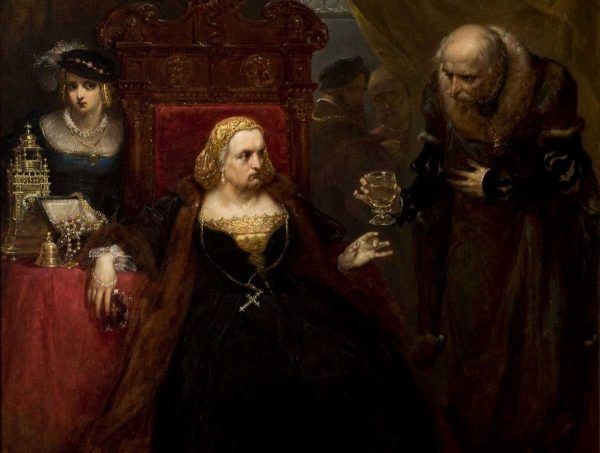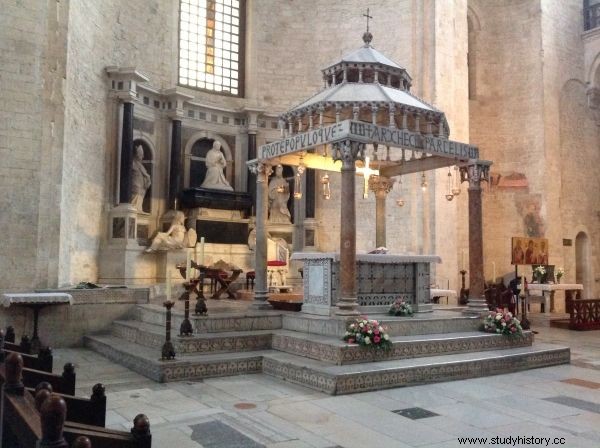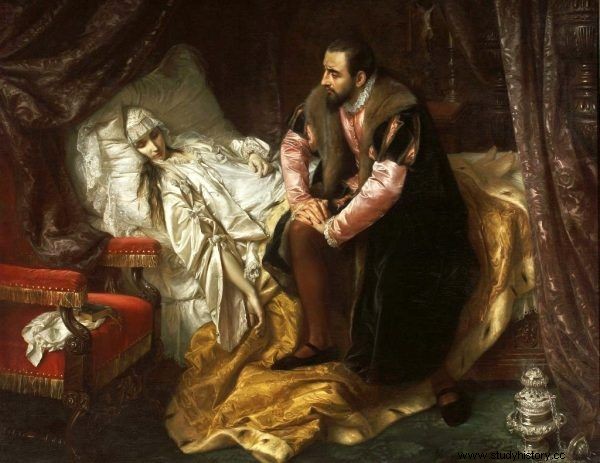"Greedy, perverse, bad mother, bad wife!" - people sang in Poland about the old Queen Bona. Her subjects accused her of murdering political opponents and sending her new daughters-in-law to the other world in cold blood. This is bullshit. The fact that Bona practiced black magic is not a similar nonsense. And so did her whole family.
Naples, a few hours ago teeming with life, full of guests intoxicated with fun and alcohol, plunged into a deep sleep. Only the bitten moon, in the last quarter tonight, shed a little light on the maze of narrow, winding streets that twine the foothills of Vesuvius like the tentacles of an octopus.
Even the city guards couldn't fight the drowsiness. So no one could notice how the gates of Castel Capuano opened in the middle of the night. It is here, in the magnificent palace, hugging the north wall of the city, that for two weeks there were noisy balls, parties and festivities organized by Princess Isabella of Aragon.
The profligacy of the hostess was breathtaking. But the reasons for the celebration were quite extraordinary - the very next day her daughter, 21-year-old princess Bona Sforza, was about to conclude a wedding contract with one of the most coveted bachelors of Europe. The king of Poland, Zygmunt I himself, sent his deputies to her.

Neapolitan Castel Capuano in a painting by Carlo Coppola. It was there that the marriage of Bona and Zygmunt was decided (source:public domain).
A secret ritual in a seaside grotto
If anyone had watched the inconspicuous carriage as it passed the city gate, he would have been surprised to see that Bona was its passenger. She wore a flowing robe with a hood and was accompanied by two similarly clothed women - a friend nun and an elderly lady of the court.
The hair is a lovely pale tan, while (oddly enough) the eyelashes and eyebrows are completely black. Straight nose, no hump or curve. The mouth is the reddest of the coral, the teeth are even and extraordinarily white, the breast is snow white - this is how the young princess was described by newcomers from Poland.

The article was written in connection with the book by Kamil Janicki. Ladies of the golden age (Horizon Label 2014). Buy with a discount on empik.com.
Now, however, in plain clothes, without makeup, with an expression of fear on her face, she looked nothing like a proud aristocrat. And no wonder. She was about to take part in a ritual as mysterious as it was dangerous. And at the same time - strictly forbidden by church authorities.
She set off to the ruins of a Roman amphitheater outside the city. There, the famous local "necromancer" was waiting for them in a fearful and thick smoke filled cave by the sea. He undertook to summon the spirits of Bona's ancestors and with their help to determine what her future would be. It was just supposed to be fun.
The future queen wanted to taste the forbidden fruit. As befits a daughter of an epoch fascinated with magic and supernatural forces, she demanded a thrill. She wanted an adrenaline rush. She quickly began to curse her own urges and regret this irresponsible trip. But it was too late.

It was in the ruins of this Roman amphitheater that Bona took part in a mysterious ritual aimed at summoning the ancestors of the future Polish queen from the afterlife (photo:Roberto Rive; license public domain).
Father's ghost and unwanted prophecy
Among the smoke and shadows dancing on the walls, the terrified Sforzówna noticed the silhouette of her deceased father Giangaleazz. The spirit revealed to her that the cause of his premature death in sorrows was not at all due to any mysterious disease she had so far believed. In fact, he "went out like an innocent lamb" after his own uncle - the sly and ruthless Ludwik Sforza - treated him with poison.
It wasn't the only revelation waiting for an overly curious princess tonight. As a punishment for breaking the veil separating the world of the living from the land of the dead, the apparition revealed to the future Polish queen that her fate would not be any better. She was to follow in her father's footsteps and also perish when poisoned by her closest people.
The next morning, the sleepy and terribly pale Bona was found lying with a cross in front of the altar in the cathedral of Saint Januari. But it was too late to appease fate.
A deadly omen
The described events really took place. A magic ritual with the participation of a princess has been reported in reliable historical sources. You can discuss details - what exactly Bona noticed and what emotions were tormenting her. You can also try to find the truth behind the magic ceremony. Was it just a skilled hoax? Was the alleged necromancer merely a gifted swindler?
This article has more than one page. Please select another one below to continue reading.Attention! You are not on the first page of the article. If you want to read from the beginning click here.
Whatever the case may be, one thing is beyond doubt. On November 19, 1557, almost exactly forty years later, Bona Sforza will die at the hands of his trusted advisor and courtier, Jan Lawrence Pappacoda.

Poisoning of Queen Bona in the painting by Jan Matejko (source:public domain).
Her entire court will be involved in a plot to kill the old queen. The frightened medic will dissolve the poison in her medications. The bribed cook will add it to the monarch's favorite dish. The greedy maid will help fake the will.
Such an ending will come as no surprise to anyone but the Queen herself. Bona - one of the richest and most powerful women of her time - was blessed with universal hatred in the fall of her life. Even his own son, King Zygmunt August, despised her so much that he refused to bury the maternal body.
They will lie in the sacristy of St. Nicholas in the Italian Bari, becoming a peculiar, even fairly popular attraction. Local priests will show them to selected guests because - as Mikołaj Czarny Radziwiłł explained - the body remained "whole, only one part of the upper lip has deteriorated".

The mausoleum and tomb of Bona Sforza in the Basilica of Saint Nicholas in Baria (photo by Kamil Janicki).
The lack of respect and elementary human decency did not prevent the new Polish ruler from drawing on the experiences of his hated mother. From her, he learned the art of government and diplomatic techniques. From her, he also took over his passion for the secret arts.
Poisons and curses
The ritual performed in December 1517 in no way alienated Bona from magic. On the contrary. It was enough for the memory of the fear accompanying the session to fade, and the queen undertook new experiments with supernatural forces. She abandoned the ordered art of alchemy in favor of folk magic. She employed witches and healers at her court.
Zygmunt August sincerely believed that the task of at least one of these women - a witch called "Big Ozog" - was to murder his beloved wife from a distance. Bona certainly did not poison Barbara Radziwiłłówna, as historians previously claimed.
It cannot be ruled out, however, that she put the case in the hands of professionals straight from the wilderness of Lithuania. And that instead of an easily detectable, risky assassination, she preferred to resort to ... a murderous curse.
From the perspective of historical sources, one can only add that the terrified Sigismund Augustus ordered the arrest of "Wielki Ozog" and throwing the witch into the dungeon. At the same time, he devoted himself to studying the secret arts. What Bona had been passionate about, he turned into a true obsession.

Zygmunt August sincerely believed that behind the death of his beloved Barbara there was a witch called "The Big Ozog", sent by Bona. The illustration shows the last moments of Barbara by Jan Matejko (source:public domain).
Like a mother, such a son
Marcin Bielski wrote in his chronicle that the king "eagerly asked about magic and alchemy". He employed a crowd of alchemists and astrologers. He made key political decisions based on fortune-telling or horoscopes. At Wawel, he even had a special room, the walls of which were painted with various magical signs with meticulous accuracy.
It was in this multi-colored room that the magicians made their predictions. And as historian Marek Wrede stated, some of them "were able to fascinate even skeptics". One of the astrologers predicted Zygmunt August that he would die in 1552. He was not much wrong. It was this year that the tragic incident took place during the ceremonial entry of the king to Konigsberg.
This article has more than one page. Please select another one below to continue reading.Attention! You are not on the first page of the article. If you want to read from the beginning click here.
A volley of cheers was fired from the walls. The bullets shouldn't even have come near the parade. Meanwhile, one of them passed the monarch by centimeters, hitting the courtier who was riding next to him. The unfortunate man was swept off his horse and torn to shreds. Regardless of whether it was an attack by the Hohenzollerns or just an accident - Sigismund Augustus began to listen to the horoscopes very carefully.

The article was written in connection with the book by Kamil Janicki. Ladies of the golden age (Horizon Label 2014). Buy with a discount on empik.com.
With age, he decided to combine business with pleasure. He listened to the advice of the sages who were skilled in the secret arts and of the rotten sorceresses who made their first infusions in the times of Kazimierz Jagiellończyk. However, he preferred to surround himself with their daughters and granddaughters. They served him not only as witches, but above all - skilled in the art of love of a mistress. The aging and ailing king emphasized at every step that these were "his hawks". And that only they keep him alive.
The mark of a dark ritual
If that was their role, the royal courtesans did not manage to save Sigismund Augustus from the next horoscope. Many years earlier, the court astrologer Piotr Proboszczowicz had foretold the ruler that he would die in the seventy-second year. The king always thought he was seventy-two years old - that he would live to be almost as old as his father. However, Zygmunt was unable to outsmart fate. He "parted with this world" on July 7, 1572.

Sigismund II Augustus was convinced that he would live to a ripe old age. It turned out, however, that he completely misinterpreted the horoscope set by the astrologer (source:public domain).
Historians enumerate a whole litany of diseases plaguing the ruler, which were to ultimately lead to his death. But there is also another explanation. According to court rumors, Zygmunt August died immediately after drinking a badly prepared love brew. A rejected lover suggested it to him. Perhaps she was unable to come to terms with the loss of the ruler's feelings. Maybe she'd rather see him dead than in another woman's embrace.
Or someone might say that her motivations didn't really matter. And that Bona Sforza had already determined the fate of Zygmunt and the entire, dying dynasty. On that fateful night in a cave outside Naples, she decided to explore matters that should remain hidden from mortals.
Source:
You can learn more about the confusing history of the Jagiellonian family in Kamil Janicki's book Ladies of the golden age (Horizon Label 2014). The article is based on the literature and materials collected by the author during the work on the book. You can buy it at a discount on empik.com.
